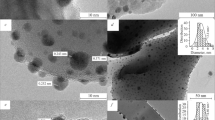Abstract
The heterogeneous reaction of formaldehyde (HCHO) on the surface of titanium dioxide (TiO2) was investigated in situ using diffuse reflectance infrared Fourier transform spectroscopy (DRIFTS) combined with ion chromatography (IC), X-ray diffraction (XRD), and transmission electron microscopy (TEM). Formate, dioxymethylene, methoxy, and polyoxymethylene were observed in the infrared spectra of TiO2 particles during the reaction. On the surface of TiO2, the adsorbed HCHO was first oxidized to dioxymethylene and further oxidized to formate. The effects of temperature and ultraviolet radiation (UV) on the reaction products and reactive uptake coefficients were studied, and the results indicate that the reaction rate can be accelerated at increasing temperatures as well as under UV. The heterogeneous reaction mechanisms of HCHO on the surface of TiO2 in the dark and under UV irradiation are proposed. Kinetic measurements show that formate formation on TiO2 is second order in HCHO concentration and the initial reactive uptake coefficients at room temperature calculated with the Brunauer-Emmett- Teller specific surface area are (0.5–5) × 10−8 ([HCHO]: 1 × 1013−2 × 1014 molecules/cm3). A linear function relationship exists between the uptake coefficient and the concentration. The apparent activation energy of the reaction was also determined.
Similar content being viewed by others
References
Grosjean D. Formaldehyde and other carbonyls in Los Angeles ambient air. Eniron Sci Technol, 1982, 16: 254–262
Possanzini M, Palo V, Petricca M, Fratarcangeli R, Brocco D. Measurements of lower carbonyls in Rome ambient air. Atmos Environ, 1996, 30: 3757–3764
Busca G, Lamotte J, Lavalley JC, Lorenzelli V. FT-IR study of the adsorption and transformation of formaldehyde on oxide surfaces. J Am Chem Soc, 1987, 109: 5197–5202
Chen MT, Lin YS, Lin YF, Lin HP, Lin JL. Dissociative adsorption of HCOOH, CH3OH, and CH2O on MCM-41. J Catal, 2004, 228: 259–263
Kecskés T, Raskó J, Kiss J. FTIR and mass spectrometric studies on the interaction of formaldehyde with TiO2 supported Pt and Au catalysts. Appl Catal A: Gen, 2004, 273: 55–62
Carlos-Cuellar S, Li P, Christensen AP, Krueger BJ, Burrichter C, Grassian VH. Heterogeneous uptake kinetics of volatile organic compounds on oxide surfaces using a Knudsen cell reactor: Adsorption of acetic acid, formaldehyde, and methanol on α-Fe2O3, α-Al2O3, and SiO2. J Phys Chem A, 2003, 107: 4250–4261
Xu BY, Zhu T, Tang XY, Ding J, Li HJ. Heterogeneous reaction of formaldehyde on surface of α-Al2O3 particles. Chem J Chin Univ, 2006, 27(10): 1912–1917
Liu HM, Lian ZW, Ye XJ. Kinetic analysis of photocatalytic oxidation of gas-phase formaldehyde over titanium dioxide. Chemosphere, 2005, 60(5): 630–635
Shie JL, Lee CH, Chiou CS. Photodegradation kinetics of formaldehyde using light sources of UVA, UVC and UVLED in the presence of composed silver titanium oxide photocatalyst. J Hazard Mater, 2008, 155(1–2): 164–172
Zhang X, Liu QQ. Visible-light-induced degradation of formaldehyde over titania photocatalyst co-doped with nitrogen and nickel. Appl Surf Sci, 2008, 254(15), 4780–4785
Popova GY, Andrushkevich TV, Chesalov YA, Stoyanov ES. In situ FTIR study of the adsorption of formaldehyde, formic acid, and methyl formiate at the surface of TiO2 (anatase). Kinetics Catal, 2000, 41(6): 805–811
Yumura T, Amenomori T, Kagawa Y, Yoshizawa K. Mechanism for the formaldehyde to formic acid and the formic acid to carbon dioxide conversions mediated by an iron-oxo species. J Phys Chem A, 2002, 106: 621–630
Augugliaro V, Coluccia S, Loddo V, Marchese L, Martra G. Photocatalytic oxidation of gaseous toluene on anatase TiO2 catalyst: Mechanistic aspects and FT-IR investigation. Appl Catal B: Environ, 1999, 20: 15–27
Raillard C, Hequet V, Le Cloirec P. TiO2 coating types influencing the role of water vapor on the photocatalytic oxidation of methyl ethyl ketone in the gas phase. Appl Catal B, 2005, 59(3–4): 213–220
Boularnanti AK, Korologos CA, Philippopoulos CJ. The rate of photocatalytic oxidation of aromatic volatile organic compounds in the gas-phase. Atmos Environ, 2008, 42(34): 7844–7850
Author information
Authors and Affiliations
Corresponding author
Rights and permissions
About this article
Cite this article
Xu, B., Zhu, T., Tang, X. et al. Heterogeneous reaction of formaldehyde on the surface of TiO2 particles. Sci. China Chem. 53, 2644–2651 (2010). https://doi.org/10.1007/s11426-010-4158-x
Received:
Accepted:
Published:
Issue Date:
DOI: https://doi.org/10.1007/s11426-010-4158-x




